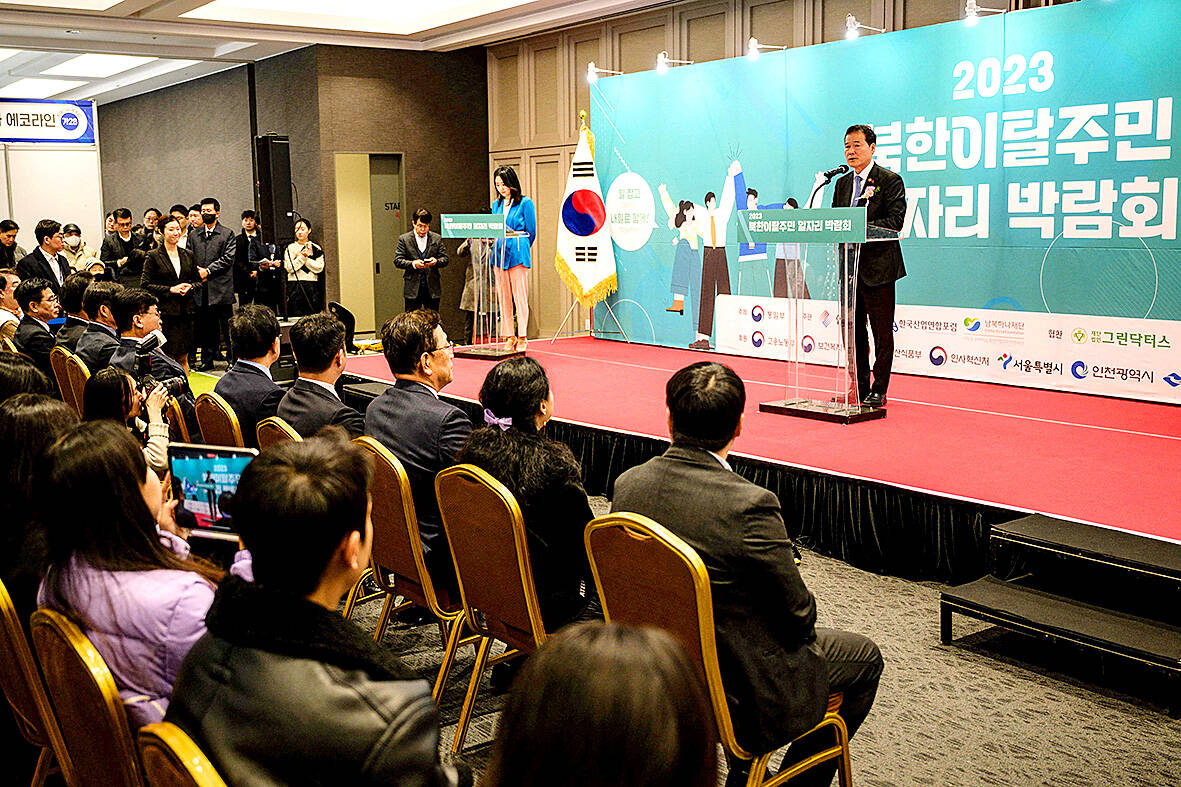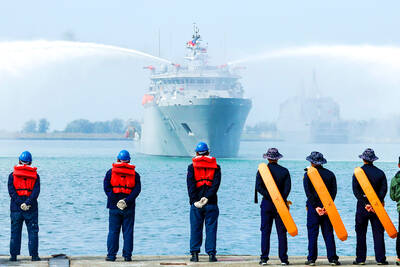One stormy night in May, Kim loaded his family into his home-made wooden boat and sailed away from North Korea, hoping to give his children a life of freedom.
Tens of thousands of North Koreans have fled to South Korea since the peninsula was divided by war in the 1950s, but most go overland to neighboring China first.
Defecting by sea is extremely rare and seen as far more dangerous than land routes, with only a handful of people making it across the de facto maritime border, the Northern Limit line.

Photo: AFP
But Kim, a 31-year-old fisherman who asked that AFP use only his surname for security reasons, was confident he could pull it off — and, after two failed attempts, he finally managed to get his family of nine out of the country.
For months, he studied border patrol patterns and waited until an opportunity arose: when North Korea started lifting its coastal blockades after the COVID pandemic lockdown.
“I studied the terrain and weather conditions and set out on the worst night when there was a sea warning in effect,” he said.

Photo: AFP
Everyone in his family — even his three-year-old — worked together to ensure the success of their escape, he said.
‘ANYTHING IS POSSIBLE’
“It feels like I was born a second time,” Kim said.
“In the North, planes flying in the sky were something I only saw in my dreams, in movies and in TV dramas, but now I can actually ride it and it feels like I’ve been born in my next life.”
After months of debriefing, Kim is now ready to move on with his new life, and attended a major job fair for North Koreans organized by authorities in South Korea — the first such event in nine years.
Some defectors have struggled to integrate. Decades of division coupled with South Korea’s rapid economic development, mean there are linguistic, cultural and practical challenges to overcome.
The job fair is one of many initiatives organized by the government that seek to assist defectors.
Kim was visibly blown away by dozens of job possibilities at the fair held at the COEX Convention Centre, in which about 100 companies and public institutions took part.
“Since I come directly from the North, I’m quite surprised that such a culture exists,” he said, clutching a pile of employment brochures.
Kim, who spent years working in North Korea’s fishing industry, said he had long dreamed of being a ship navigator — something that was impossible in his former home. North Korea’s shipping industry is tightly controlled, with access to jobs very restricted, and dependent on having the right background and connections.
“For ordinary people, (becoming a navigator) could only be a grandiose dream,” Kim said.
“But here, I heard that anything is possible if you put in a little effort, so I’m going to give it a try.”
‘ABSURD BRAINWASHING’
Kim had led a quiet, diligent life in North Korea, working towards owning his own boat one day.
He started off as a crew member on a fishing boat and then learned to dive to make more money.
Kim eventually earned enough to build a wooden boat, which he operated for around five years before setting out on his risky sea voyage to South Korea.
He said that he decided to defect after his children returned home one day from an “absurd brainwashing session.”
“I wanted them to be able to do, to say, and to see whatever they want, which basically does not exist in North Korea,” Kim said.
“I wanted to show them that there is a better world, that there is a bigger world out there,” he said.
“You can lead a stable life in North Korea now if you plan well and work hard, but there is no freedom.”

March 10 to March 16 Although it failed to become popular, March of the Black Cats (烏貓進行曲) was the first Taiwanese record to have “pop song” printed on the label. Released in March 1929 under Eagle Records, a subsidiary of the Japanese-owned Columbia Records, the Hoklo (commonly known as Taiwanese) lyrics followed the traditional seven characters per verse of Taiwanese opera, but the instrumentation was Western, performed by Eagle’s in-house orchestra. The singer was entertainer Chiu-chan (秋蟾). In fact, a cover of a Xiamen folk song by Chiu-chan released around the same time, Plum Widow Missing Her Husband (雪梅思君), enjoyed more

Last week Elbridge Colby, US President Donald Trump’s nominee for under secretary of defense for policy, a key advisory position, said in his Senate confirmation hearing that Taiwan defense spending should be 10 percent of GDP “at least something in that ballpark, really focused on their defense.” He added: “So we need to properly incentivize them.” Much commentary focused on the 10 percent figure, and rightly so. Colby is not wrong in one respect — Taiwan does need to spend more. But the steady escalation in the proportion of GDP from 3 percent to 5 percent to 10 percent that advocates

From insomniacs to party-goers, doting couples, tired paramedics and Johannesburg’s golden youth, The Pantry, a petrol station doubling as a gourmet deli, has become unmissable on the nightlife scene of South Africa’s biggest city. Open 24 hours a day, the establishment which opened three years ago is a haven for revelers looking for a midnight snack to sober up after the bars and nightclubs close at 2am or 5am. “Believe me, we see it all here,” sighs a cashier. Before the curtains open on Johannesburg’s infamous party scene, the evening gets off to a gentle start. On a Friday at around 6pm,

A series of dramatic news items dropped last month that shed light on Chinese Communist Party (CCP) attitudes towards three candidates for last year’s presidential election: Taiwan People’s Party (TPP) founder Ko Wen-je (柯文哲), Terry Gou (郭台銘), founder of Hon Hai Precision Industry Co (鴻海精密), also known as Foxconn Technology Group (富士康科技集團), and New Taipei City Mayor Hou You-yi (侯友宜) of the Chinese Nationalist Party (KMT). It also revealed deep blue support for Ko and Gou from inside the KMT, how they interacted with the CCP and alleged election interference involving NT$100 million (US$3.05 million) or more raised by the